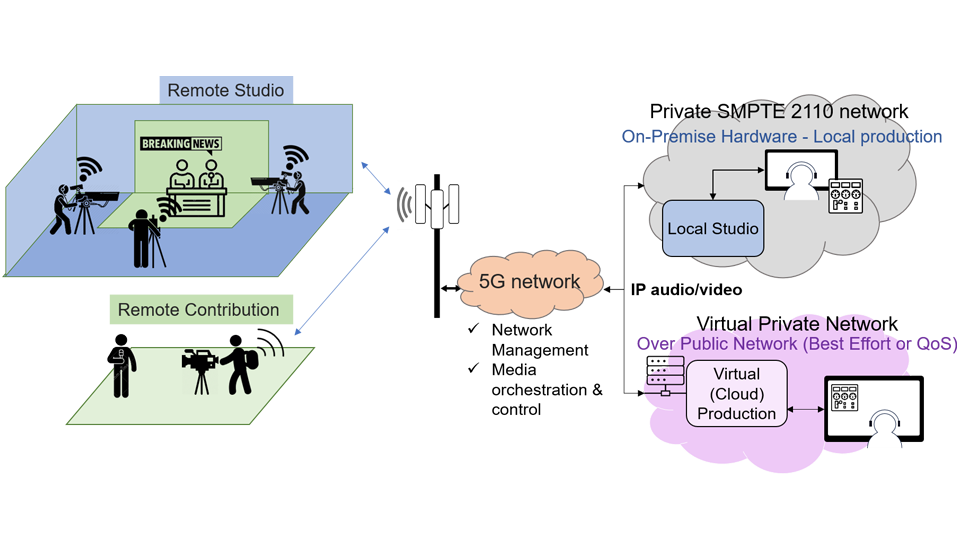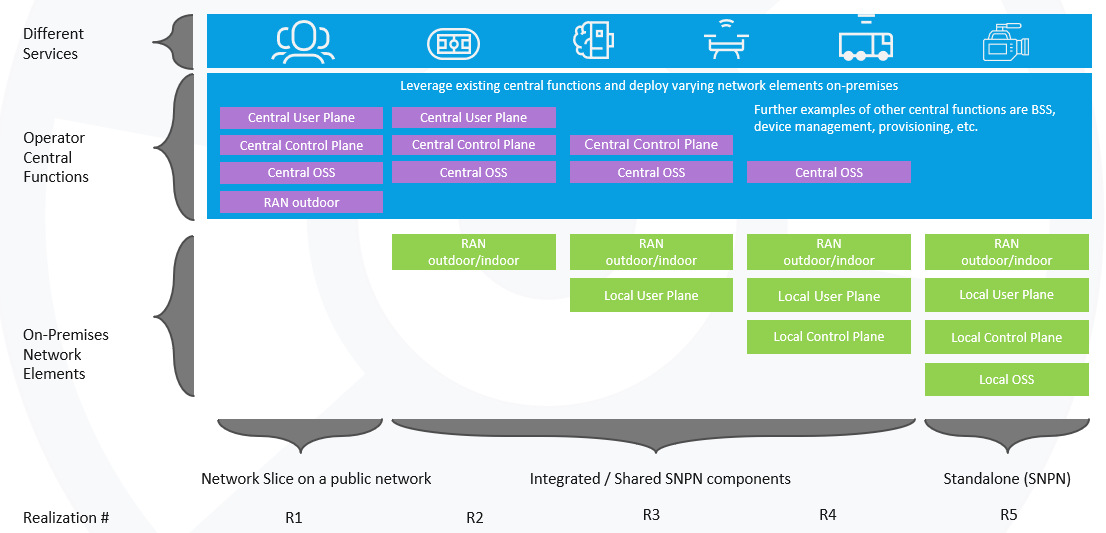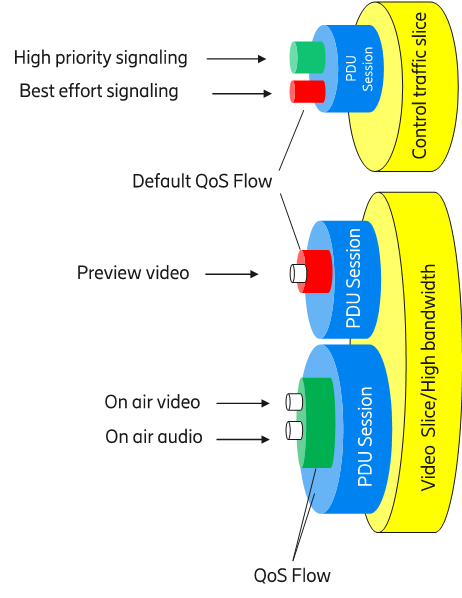FAQ
Introduction
Audio and video productions – such as television and radio studios, live news gathering, sports events or music festivals – typically require numerous wireless devices. These include wireless microphones, in-ear monitoring systems and cameras.
Traditionally, media production teams have used specialist radio services. In the future, the wireless communication service for such devices could potentially be provided by a 5G system. What are the requirements of such systems for professional AV productions?
In this FAQ, we aim to provide information derived from the 5G RECORDS project, focusing in particular on 5G NPN (Non-Public Network): What is this NPN? Why is it interesting in the context of professional media production? How can it be deployed for media production?
| Because 5G supports natively IP communication and media productions are moving towards IP production (local, in the cloud). 5G will allow also to multiplex different types of signals (e.g., audio, video, return video, talkback and command controls) in one single infrastructure instead of using different radio links as it happens today. |
Q2 – What does 5G have over 4G?
|
The capabilities of the 5G components have improved compared to 4G components: • Support for much larger bandwidth, allowing for higher bitrates. • Dedicated support for private network by means of NPN support • Support for IP native deployments, allowing for more flexible, agile, and distributed deployments. • Support for time-synchronization over 5G • Network slicing and QoS support in 5G is more flexible than 4G, • More flexible uplink/downlink ratio |
Q3 – Public versus non-public networks: What’s the difference?
|
A Public Land Mobile Network (PLMN) is a mobile network operated by a Mobile Network Operator (MNO) in a specific country intended for telecommunication services. They are the most prevalent mobile networks today and have wide area coverage. The spectrum regulation typically assigns several obligations to be provided by public networks, most importantly the capability of supporting emergency call services. The spectrum regulation typically assigns several obligations to be provided by public networks, most important the capability of supporting emergency call services. A Non-Public Network (NPN) - sometimes referred to as a private network - is a network that is dedicated to a specific set of devices within a dedicated area. These networks can potentially be tuned for performance or uplink vs. downlink balance if the regulation permits it (e.g., interferences generation) NPNs are often local and cover a small service area, but they can also be deployed over a wider area, which offers the possibility to support nomadic and ad-hoc audiovisual content production applications and workflows, independently of PLMN coverage availability. Media producers will need to determine the type of network they need depending on the individual scenario, including the redundancy required to run the equipment smoothly and without interruption. |
Q4 - How can a 5G network be deployed?
|
A 5G non-public networks (see Q3) can be deployed in several ways: • As a PNI-NPN, they can be Integrated into a PLMN (Public Land Mobile Network) and connected to an MNO (Mobile Network Operator) network, • As as a Standalone Non-Public Network (SNPN), they are deployed independently of any other network known. PNI-NPN and SNPNs are useful as they allow dedicated 5G connectivity for a restricted number of users in a more secure environment but also allow those users to tune a network to their own requirements. An example of media production that rely on PLMN for the remote contribution link and on 5G standalone network for the multi-cam production in the remote studio is reported in Figure 1. Figure 1 - A 5G wireless studio.
|
Q5 – What are the basic S-NPN (Non-Public Network) deployment models?
|
A The deployment of a Standalone NPNs (S-NPN) (see Q4) requires dedicated spectrum access and management. Some regulatory authorities have reserved specific spectrum for the purpose of S-NPNs (e.g. 3.7 - 3.8 GHz in Germany). S-NPNs potentially offer the most flexibility and performance since dedicated optimisations for specific use cases are possible. they support the wireless connectivity of a constrained set of several devices separate to any public network that may be in the area. They are likely to be deployed and managed by specialist engineers, similarly to how we manage our existing radio cameras and microphones. Figure 2 shows the different level of integration with the operator: from a slice on a public network (PNI-NPN) to a private standalone network.
|
|
A In order to deploy a standalone NPN, there are a number of factors and requirements that need to be considered. As with traditional radio equipment used on production, it is necessary to gain the relevant spectrum licence for use of spectrum at the correct power levels in the target area. The ability to do this will often be dictated by local regulations and may be constrained for indoor or outdoor use only. Depending on the type of application there may be advantages to use different spectrum bands for different applications with higher frequencies providing more bandwidth, but they also have less range and may not be as robust. The next consideration is the amount of bandwidth required on both the uplink and downlink. Cameras will require a larger share of the bandwidth than audio, and the higher quality needed, the more bandwidth required. Other factors in this equation include latency and robustness. A high quality, low latency, robust connection used for programme output will require more bandwidth per device than a lower quality signal that could be used for a reverse video or audio stream. Uplink vs. downlink balance is also a critical aspect as media production requires both to be the same but downlink is generally prioritized in telecom networks. As 5G is a 2-way IP-based network, it is possible to include all traffic, not only audio and video, within a single connection. This data can be used to carry control, timing or other ancillary data that may be required by the end user device. Some additional attributes that are relevant to the deployment of standalone NPNs include: • Autonomy and control • Isolation • Security • Deployment flexibility |
Q7 – How do 3GPP specification releases relate to NPN features?
|
A For shorter definitions of Non-Public Networks (NPN), Standalone Non-Public Networks (S-NPN), and Public Network Integrated NPN networks (PNI-NPN), see Q3 and Q4. 3GPP defines the concept of a NPN in Release 16. NPNs refer to a 5G System (5GS) deployed for private use. The requirements to enable NPNs for video, imaging and audio for professional applications are described in 3GPP TS 22.261 with additional media production requirements detailed in 3GPP TS 22.287. An S-NPN is identified by a combination of a PLMN ID and Network identifier (NID). At the UE (user equipment), these two parameters need to be configured to access the S-NPN. The PLMN ID may be one assigned in the range of PLMN IDs for private networks (e.g. based on MCC 999, as assigned by the ITU). Note that a UE connected to an S-NPN may also be able to access services from a PLMN where available. In such case, the UE is required to authenticate in both networks. Release 16 specifications do not include support for roaming, handover between S-NPNs not interworking with Evolved Packet Core (EPC). Such networks can be tailored to support specific requirements such as increased uplink / downlink (see Q6), which is beneficial for high uplink scenarios such as cameras and microphones. It is unlikely that such a network would be used for contribution workflows but are more likely to deployed in small, controlled areas with limited coverage areas. They are completely isolated from other networks and therefore are unlikely to suffer from congestion or contention if properly designed. 3GPP Release 16 also defines a PNI-NPN as an NPN deployed with the support of at least one PLMN. Two deployment solutions are normative: - PNI-NPN deployment by means of dedicated Data Network Names (DNNs). The DNN defines a dedicated gateway (UPF) in the PLMN to/from which NPN traffic is conveyed and dispatched to the NPN local area network. - PNI-NPN deployment by means of network slicing. The PLMN provisions a dedicated slice of the PLMN comprising a set of resources allocated for the exclusive use of the NPN. This type of network will rely on the provision of some shared services and so it may not be possible to adjust uplink/downlink balance or other QoS metrics as they will be dependent on the host network. They will therefore depend on the agreement with the host network to ensure the QoS. The NPN architecture has been enhanced in Release 17, including the following: • Enable support for SNPN along with subscription/credentials owned by an entity separate from the SNPN operator. • Support UE onboarding and provisioning for NPNs. • Support audio–visual content production service requirements, e.g. for service continuity • Support voice/IMS emergency services for SNPN. |
Q8 – How do Network Slicing and QoS work?
|
A The 3GPP system offers different solutions to separate and prioritize traffic. Since early releases, 3GPP offers the capability to allow a UE (user equipment) to connect to one or more data network (DN), like different Virtual Private Networks (VPN). The UE establishes one or more PDU Sessions to (typically) different Data Networks. In 5G, this capability is extended by Network Slicing. Network slicing enables the virtualization of the network resources in both radio and core. It gives the flexibility for the network operator to create multiple separate virtual networks on top of the physical network resources. A separate slice allows the network operator to tailor the network characteristics to fulfill the requirements needed per use case i.e., slice users. Slice separation also allows the Edge cloud to be only accessible by the slice users. There are two basic realization alternatives with Network Slices: (1) Using a single Network Slice in combination with multiple QoS Flow. The Network Slice separates the traffic of a Media Producer from other eMBB (enhanced mobile broadband) traffic and provides a defined capacity for the media producer. QoS is used within the Network Slice, in order to prioritise the different Media Production related flows against each other. (2) Using multiple Network Slices. For example, Slice A is used for media streaming, where the slice can be optimized to provide high capacity. Slice B is used for control signal which can be optimized for low latency. Slice C can be used for any other non-critical traffic. QoS plays an important role in prioritising streams within the same slice. The usage of QoS is essential to ensure that the radio scheduler assigns the needed resources to a given flow. For example, two video streams can compete on resources within the media slice. If one stream is considered by the production facility more important than the other stream, the network operator can assign a QoS value to that stream. QoS assignment can be modified dynamically using APIs that can be triggered from the media orchestrator towards the Network Exposure Function (NEF). Therefore, the priority of a certain stream can change according to the production process requirements. The concept of using network slicing in combination with QoS is depicted in Figure 3.
Figure 3 – Slices and QoS (Source: Ericsson). |
Q9 – What competences are needed to set up a 5G S-NPN?
|
A The list below is not exhaustive: • Secure spectrum planning and reservation. • Radio planning: This often includes a terrain scan. Sector positions and sector sizes need to be planned, based on the terrain information. • Power and connectivity planning: Power Generators may be used outdoors. Connectivity planning includes the deployment of e.g. fiber networks (when not available at the event site) • Setup execution: Starting from basic hardware installation (radios, switches, different compute units), and including connectivity establishment (putting the plugs into the right sockets). • System planning: IP address plans, QoS rules, like VLAN QoS or DiffServ, security zones, 5G System configuration • Radio performance optimization. |
Q10 – How is spectrum licensed?
|
Radio spectrum is, necessarily, a highly regulated area. Spectrum availability remains essential for conventional wireless production equipment as well as for 5G‑based solutions. Certain spectrum bands are more technically suitable for specific PMSE (Programme Making and Special Events) applications. Furthermore, licensing models should be suitable for different operational needs, including permanent and temporary, stationary and nomadic production use cases. Spectrum licensing can take a number of different forms. For conventional PMSE services some possibilities include: • Long term fixed site licensing, suitable for a location where productions are continuous and can demonstrate regular demand, perhaps a film or TV production center with multiple stages or studios, it may be appropriate to authorize long-term spectrum access. • Short-term temporary licensing, suitable for short-term events there is a requirement for temporary spectrum access in some specific locations (e.g. sports venues, festivals and other outdoors events) over flexible periods of time, which could be as short as few hours or as long as several weeks. The amount of spectrum required can vary depending on the nature of the production; the duration for which it is needed can be from a few hours to many days, or permanently. In contrast, the way spectrum is currently allocated to 5G services means that access is provided on a long‑term basis (e.g. several years). With regard to spectrum access for 5G NPNs, there is a substantial difference between Public Network Integrated NPNs (PNI-NPNs) and Standalone NPNs (S-NPNs) (see Q3 and Q7): • PNI-NPNs are provided by mobile network operators and operate in the spectrum the same way as the public mobile networks (PLMNs). • For SNPNs, spectrum is licensed on specific permanent locations (e.g. a factory or a studio) but the options for temporary deployments are limited. This is not optimal for those PMSE applications that require spectrum only temporarily over short periods of time and at non-permanent locations. For the content production sector, it is important that spectrum access for PMSE services, whether conventional or 5G-based, remains easy, affordable and timely. Another important requirement is long term access to internationally harmonized spectrum bands. Furthermore, spectrum allocations for NPNs ideally should be defined in such a way as to allow the same hardware to operate in both public and non-public 5G networks (see Q3). A detailed treatment of spectrum licensing options for 5G NPNs is provided in the 5G-RECORDS deliverable D2.2 5G regulatory framework for content production |
Q11 – Can NPN be implemented using technologies different from 5G?
|
The concept of NPN (see Q3) could be applied using other technologies such as 4G, by ensuring that the company has exclusive access and control over the different network components. This is not limited only to computational resources but also to the transport medium (e.g., radio resources and backhaul). Note, one benefit of using 5G networking technology is the reuse of radio equipment for different deployments. For example, a Device, which is used for a 5G SNPN during a first production, can be used within a 5G PNI-NPN for another production. The guaranteed resources can be utilized either using physical resources or using virtualization such as network slicing in 5G. The usage of a licensed band guarantees that the radio resources are secured and not prone to interference from unexpected users of the same radio frequency used by the company. For instance, Because WIFI Access Points operate in the unlicensed band 2.5GHz,5GHz and 6GHz for WiFi6E, the media production facility cannot guarantee that the radio resources are not shared with other users. For example, a neighboring WIFI Access Point (AP) can operate on the same frequency band used by the media production facility, causing interference which will result in unexpected behavior. |



